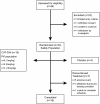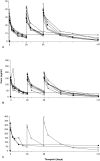A phase 1 study evaluating the pharmacokinetics, safety and tolerability of repeat dosing with a human IL-13 antibody (CAT-354) in subjects with asthma
- PMID: 20064211
- PMCID: PMC2820465
- DOI: 10.1186/1471-2466-10-3
A phase 1 study evaluating the pharmacokinetics, safety and tolerability of repeat dosing with a human IL-13 antibody (CAT-354) in subjects with asthma
Abstract
Background: IL-13 has been implicated in the development of airway inflammation and hyperresponsiveness. This study investigated the multiple-dose pharmacokinetics and safety profile of human anti-IL-13 antibody (CAT-354) in adults with asthma.
Methods: This was a multiple-dose, randomised, double-blind, placebo-controlled phase 1 study in asthmatics (forced expiratory volume in 1 second [FEV1] >or= 80% predicted). Subjects were randomised to receive three intravenous infusions of CAT-354 (1 mg/kg, 5 mg/kg or 10 mg/kg) or placebo at 28-day intervals. Blood samples were taken for pharmacokinetic measurements. Safety was assessed by adverse events, vital signs, ECGs, laboratory and pulmonary function parameters.
Results: Twenty-three subjects (aged 21-60 years, FEV1 88-95% predicted) received >or= 1 dose of study medication. The half-life of CAT-354 was 12-17 days and was dose-independent. The maximum serum concentration and area under the curve were dose-dependent. Clearance (2.2-2.6 mL/day/kg) and volume of distribution (44-57 mL/kg) were both low and dose-independent. The observed maximum serum concentration after each dose increased slightly from dose 1 through dose 3 at all dose levels, consistent with an accumulation ratio of 1.4 to 1.7 for area under the curve. Most adverse events were deemed mild to moderate and unrelated to study medication. One SAE was reported and deemed unrelated to study drug. There were no effects of clinical concern for vital signs, ECG, laboratory or pulmonary parameters.
Conclusions: CAT-354 exhibited linear pharmacokinetics and an acceptable safety profile. These findings suggest that at the doses tested, CAT-354 can be safely administered in multiple doses to patients with asthma.
Trial registration: NCT00974675.
Figures
Similar articles
-
Randomized study of the safety and pharmacodynamics of inhaled interleukin-13 monoclonal antibody fragment VR942.EBioMedicine. 2018 Sep;35:67-75. doi: 10.1016/j.ebiom.2018.07.035. Epub 2018 Aug 23. EBioMedicine. 2018. PMID: 30146344 Free PMC article. Clinical Trial.
-
Safety profile and clinical activity of multiple subcutaneous doses of MEDI-528, a humanized anti-interleukin-9 monoclonal antibody, in two randomized phase 2a studies in subjects with asthma.BMC Pulm Med. 2011 Feb 28;11:14. doi: 10.1186/1471-2466-11-14. BMC Pulm Med. 2011. PMID: 21356110 Free PMC article. Clinical Trial.
-
Efficacy and safety of tralokinumab in patients with severe uncontrolled asthma: a randomised, double-blind, placebo-controlled, phase 2b trial.Lancet Respir Med. 2015 Sep;3(9):692-701. doi: 10.1016/S2213-2600(15)00197-6. Epub 2015 Jul 28. Lancet Respir Med. 2015. PMID: 26231288 Clinical Trial.
-
RPC4046, A Novel Anti-interleukin-13 Antibody, Blocks IL-13 Binding to IL-13 α1 and α2 Receptors: A Randomized, Double-Blind, Placebo-Controlled, Dose-Escalation First-in-Human Study.Adv Ther. 2017 Jun;34(6):1364-1381. doi: 10.1007/s12325-017-0525-8. Epub 2017 Apr 28. Adv Ther. 2017. PMID: 28455782 Free PMC article. Clinical Trial.
-
Leukotriene receptor antagonists in children with cystic fibrosis lung disease : anti-inflammatory and clinical effects.Paediatr Drugs. 2005;7(6):353-63. doi: 10.2165/00148581-200507060-00004. Paediatr Drugs. 2005. PMID: 16356023 Review.
Cited by
-
Th17-mediated inflammation in asthma.Curr Opin Immunol. 2013 Dec;25(6):755-60. doi: 10.1016/j.coi.2013.08.002. Epub 2013 Sep 11. Curr Opin Immunol. 2013. PMID: 24035139 Free PMC article. Review.
-
Anti-IL5 therapies for asthma.Cochrane Database Syst Rev. 2017 Sep 21;9(9):CD010834. doi: 10.1002/14651858.CD010834.pub3. Cochrane Database Syst Rev. 2017. Update in: Cochrane Database Syst Rev. 2022 Jul 12;7:CD010834. doi: 10.1002/14651858.CD010834.pub4. PMID: 28933516 Free PMC article. Updated.
-
Population pharmacokinetics of sifalimumab, an investigational anti-interferon-α monoclonal antibody, in systemic lupus erythematosus.Clin Pharmacokinet. 2013 Nov;52(11):1017-27. doi: 10.1007/s40262-013-0085-2. Clin Pharmacokinet. 2013. PMID: 23754736 Free PMC article. Clinical Trial.
-
Interspecies comparison of human and murine scleroderma reveals IL-13 and CCL2 as disease subset-specific targets.Am J Pathol. 2012 Mar;180(3):1080-1094. doi: 10.1016/j.ajpath.2011.11.024. Epub 2012 Jan 11. Am J Pathol. 2012. PMID: 22245215 Free PMC article.
-
Safety, tolerability and pharmacokinetics of a human anti-interleukin-13 monoclonal antibody (CNTO 5825) in an ascending single-dose first-in-human study.Br J Clin Pharmacol. 2013 May;75(5):1289-98. doi: 10.1111/j.1365-2125.2012.04477.x. Br J Clin Pharmacol. 2013. PMID: 23043368 Free PMC article. Clinical Trial.
References
-
- Global strategy for asthma management and prevention. 2007. http://www.ginasthma.com Last updated.
-
- Robinson DS, Hamid Q, Ying S, Tsicopoulos A, Barkans J, Bentley AM, Corrigan C, Durham SR, Kay AB. Predominant TH2-like bronchoalveolar T-lymphocyte population in atopic asthma. N Engl J Med. 1992;326:298–304. - PubMed
Publication types
MeSH terms
Substances
Associated data
LinkOut - more resources
Full Text Sources
Other Literature Sources
Medical
Miscellaneous




